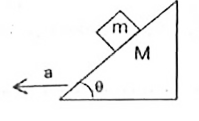A block of mass m is placed on a smooth wedge of inclination θ. The whole system is accelerated horizontally, so that the block does not slip on the wedge. The force exerted by the wedge on the block (g is acceleration due to gravity) will be
mgcosθ
mgsinθ
mg
mgcosθ
The correct Answer is:D
To solve the problem of finding the force exerted by the wedge on the block, we can follow these steps:
1. Identify the Forces Acting on the Block:
- The block of mass m experiences its weight mg acting downwards.
- Since the wedge is inclined at an angle θ, the weight can be resolved into two components:
- Perpendicular to the incline: mgcosθ
- Parallel to the incline: mgsinθ
2. Consider the Acceleration of the System:
- The entire system (wedge and block) is accelerating horizontally with an acceleration A.
- Due to this horizontal acceleration, a pseudo force Fpseudo=ma acts on the block in the opposite direction of the acceleration of the wedge.
3. Resolve the Pseudo Force:
- The pseudo force can also be resolved into components:
- Perpendicular to the incline: macosθ
- Parallel to the incline: masinθ
4. Set Up the Equilibrium Conditions:
- For the block to not slip on the wedge, the net force in the direction perpendicular to the incline must be zero.
- Thus, we can write the equation:
N−mgcosθ−masinθ=0
- Where N is the normal force exerted by the wedge on the block.
5. Solve for Normal Force N:
- Rearranging the equation gives:
N=mgcosθ+masinθ
6. Substitute the Expression for Acceleration A:
- From the equilibrium of forces along the incline, we have:
macosθ=mgsinθ
- This simplifies to:
a=gtanθ
- Substitute a back into the equation for N:
N=mgcosθ+m(gtanθ)sinθ
7. Simplify the Expression:
- Using the identity tanθ=sinθcosθ:
N=mgcosθ+mgsin2θ
- Factor out mg:
N=mg(cosθ+sin2θ)
Final Answer:
The force exerted by the wedge on the block is:
N=mg(cosθ+sin2θ)
- The block of mass m experiences its weight mg acting downwards.
- Since the wedge is inclined at an angle θ, the weight can be resolved into two components:
- Perpendicular to the incline: mgcosθ
- Parallel to the incline: mgsinθ
- The entire system (wedge and block) is accelerating horizontally with an acceleration A.
- Due to this horizontal acceleration, a pseudo force Fpseudo=ma acts on the block in the opposite direction of the acceleration of the wedge.
- The pseudo force can also be resolved into components:
- Perpendicular to the incline: macosθ
- Parallel to the incline: masinθ
- For the block to not slip on the wedge, the net force in the direction perpendicular to the incline must be zero.
- Thus, we can write the equation:
N−mgcosθ−masinθ=0
- Where N is the normal force exerted by the wedge on the block.
- Rearranging the equation gives:
N=mgcosθ+masinθ
- From the equilibrium of forces along the incline, we have:
macosθ=mgsinθ
- This simplifies to:
a=gtanθ
- Substitute a back into the equation for N:
N=mgcosθ+m(gtanθ)sinθ
- Using the identity tanθ=sinθcosθ:
N=mgcosθ+mgsin2θ
- Factor out mg:
N=mg(cosθ+sin2θ)
The force exerted by the wedge on the block is:
N=mg(cosθ+sin2θ)
Topper's Solved these Questions
Similar Questions
A block of mass m is placed on a smooth wedge of inclination. The whole system is accelerated horizontally so that block does not slip on the wedge Find the i) Acceleration of the wedge Force to be applied on the wedge Force exerted by the wedge on the block .
View SolutionA block of mass m is placed on a smooth wedge of inclination θ. The while system is acceleration horizontally so that the block does not slip. Find (a) horizontal acceleration, (b) normal force between the block and the wedge and (c) the horizontal force applied on the wedge.
View Solution
Knowledge Check
A block of mass m is placed on a smooth wedge of incination θ. The whole system s acelerated horizontally so tht the block does not slip on the wedge. The force exerted by the wedge on the block has a magnitude
AmgBmgcosθCmgcosθDmgtanθA block of mass m is placed on a smooth wedge of wedge angle θ The whole system is accelerated horizontally so that the block does not slip on the wedge. The force (normal reaction) exerted by the wedge on the block has a magnitude:
AmgtanθBmgcosθCmgDmgcosθA block of mass m is kept on an inclined plane of mass 2m and inclination α to horizontal. If the whole system is accelerated such that the block does not slip on the wedge then :
AThe normal reaction acting on 2m due to m is mgsecθBFor the block m to remain at rest with respect to wedge a force F=3mgtanα must be applied on 2mCThe normal reaction acting on 2m due to m is mgsecθDPseudo force acting on m with respect to ground is mgtanα towards west.
A block of mass m is placed on a smooth slope of angle θ.The whole system (slope + block) is moved horizontally with acceleration a in such way that the block does not slip on the slope.Hence a = ________.
View SolutionA block of mass m is placed on a smooth wedge of inclination θ & mass M. The whole system is slip on the wedge. Then the normal reaction on the wedge acting from the ground :
View SolutionBlock of mass m is stationary w.r.t. wedge. Normal force exerted by wedge on the block is

View SolutionA block mass 'm' is placed on a frictionless inclined plane of inclination θ with horizontal. The inclined plane is accelerated horizontally so that the block does not slide down. In this situation vertical force exerted by the inclined plane on the block is:
View SolutionA block of mass m is placed on a smooth inclined plane of inclination θ with the horizontal. The force exerted by the plane on the block has a magnitude
View Solution
